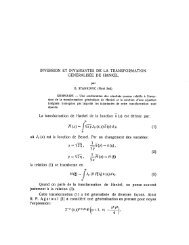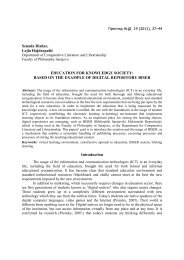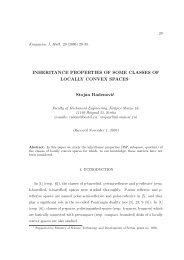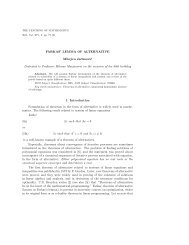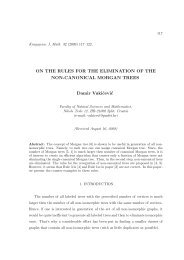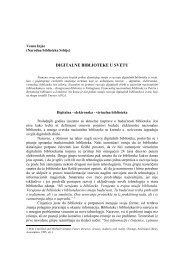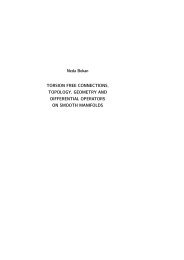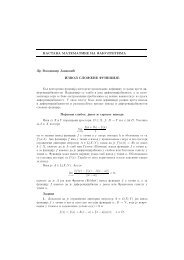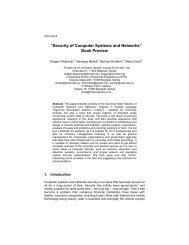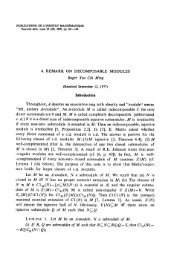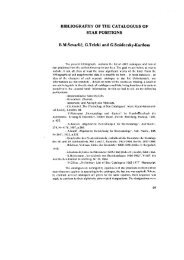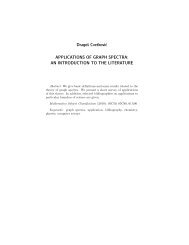HAZARD RATES AND SUBEXPONENTIAL DISTRIBUTIONS A ...
HAZARD RATES AND SUBEXPONENTIAL DISTRIBUTIONS A ...
HAZARD RATES AND SUBEXPONENTIAL DISTRIBUTIONS A ...
Create successful ePaper yourself
Turn your PDF publications into a flip-book with our unique Google optimized e-Paper software.
PUBLICATIONS DE L’INSTITUT MATH ÉMATIQUE<br />
Nouvelle série, tome 80(94) (2006), 29–46 DOI:10.2298/PIM0694029B<br />
<strong>HAZARD</strong> <strong>RATES</strong> <strong>AND</strong> <strong>SUBEXPONENTIAL</strong><br />
<strong>DISTRIBUTIONS</strong><br />
A. Baltrunas, E. Omey, and S. Van Gulck<br />
This paper is dedicated to the memory of Tatjana Ostrogorski and also to our<br />
co-author Aleksandras Baltrunas who died during the preparation of this paper.<br />
Both were infinite dimensional mathematicians and both unfortunately died too young.<br />
Abstract. A distribution function F on the nonnegative halfline is called<br />
subexponential if limx→∞(1−F ∗n (x))/(1−F (x)) = n for all n � 2. We obtain<br />
new sufficient conditions for subexponential distributions and related classes<br />
of distribution functions. Our results are formulated in terms of the hazard<br />
rate. We also analyze the rate of convergence in the definition and discuss the<br />
asymptotic behaviour of the remainder term Rn(x) =1−F ∗n (x)−n(1−F (x)).<br />
We use the results in studying subordinated distributions and we conclude the<br />
paper with some multivariate extensions of our results.<br />
1. Introduction<br />
Let X, X1,X2,...,Xn,... denote i.i.d. random variables with distribution function<br />
(d.f.) F (x) =P (X � x) and suppose that F (0+) = 0 and F (x) < 1 for all<br />
real x. If the mean of X is finite, we shall denote it by µ. The d.f. of the partial<br />
sums S(n) = �n i=1 Xi is given by P (S(n) � x) =F ∗n (x), where ∗ denotes Stieltjes<br />
convolution. Let F (x) =1− F (x) denote the tail distribution. We say that F (x)<br />
belongs to the subexponential class S (notation F ∈ S) ifasx→∞, (1) F ∗2 (x)/F (x) → 2.<br />
Unless stated otherwise, throughout the paper we shall consider limits as x →∞.<br />
It is well known that (1) holds if and only if<br />
(2) F ∗n (x)/F (x) → n, ∀n � 2.<br />
Subexponential distributions were first studied by Chistyakov (1964) and further<br />
analyzed by Teugels (1975) and Pitman (1980). In the past decades, the class<br />
2000 Mathematics Subject Classification: Primary 60E99; Secondary 60G50, 26A12.<br />
Key words and phrases: regular variation, O-regular variation, univariate and multivariate<br />
subexponential distributions, hazard rate, subordination.<br />
29
30 BALTRUNAS, OMEY, <strong>AND</strong> VAN GULCK<br />
S has been used in a wide variety of applications in probability theory and stochastic<br />
processes. For a survey we refer to Goldie and Klüppelberg (1998), Klüppelberg<br />
(2004) and Embrechts et al. (1997).<br />
It is well known that F ∈ S implies that but is not equivalent to F ∈ L, where<br />
L denotes the class of positive and measurable functions g(x) for which<br />
(3) g(x + y)/g(x) → 1, ∀y ∈ R.<br />
Thus, apart from F ∈ L we need an extra condition to conclude that F ∈ S.<br />
For densities, we define the class SD of subexponential densities as the class<br />
of densities f(x) for which f ∈ L and<br />
(4) f ⊗2 (x)/f(x) → 2<br />
holds, where ⊗ denotes the Lebesgue convolution. It is well known that for f ∈ L,<br />
(4) implies that F ∈ S and that f ⊗n (x) ∼ nf(x) for all n � 2.<br />
Related to SD and S, we say that F ∈ S∗ iff µ
<strong>HAZARD</strong> <strong>RATES</strong> <strong>AND</strong> <strong>SUBEXPONENTIAL</strong> <strong>DISTRIBUTIONS</strong> 31<br />
F ∈ OA is equivalent to F ∈ OS∗ .IfXhas an infinite mean, then it is meaningful<br />
for example to study d.f. F for which F ∈ OA.<br />
A useful way to find examples in the classes defined above is to consider regularly<br />
varying functions or O-regularly varying functions. Recall that a positive<br />
and measurable function g(x) is regularly varying with (real) index α if it satisfies<br />
g(xy)/g(x) → yα , ∀y >0. Notation g ∈ RV (α). The function g is in the class ORV<br />
of O-regularly varying functions if it satisfies g(xy)/g(x) =O(1), ∀y >0. For these<br />
classes we refer to Bingham et al. (1989) or to Seneta (1976). In what follows we<br />
shall often use the property that for g ∈ ORV or g ∈ RV (α) the defining property<br />
holds locally uniformly in y.<br />
In Lemma 1 below we provide a useful characterization of the classes S and OS.<br />
The result goes back to Goldie (1978). Lemma 1 easily follows from the following<br />
identity:<br />
(6) F ∗2 (x) =2<br />
� x/2<br />
0<br />
F (x − u) dF (u)+F 2 (x/2).<br />
Lemma 1. (i) We have F ∈ S ifandonlyifasx →∞,<br />
� x/2<br />
F (x − u)<br />
0 F (x) dF (u) → 1 and F 2 (x/2)<br />
→ 0.<br />
F (x)<br />
(ii) L We have F ∈ OS if and only if as x →∞,<br />
� x/2<br />
F (x − u)<br />
0 F (x) dF (u) =O(1) and F 2 (x/2)<br />
= O(1).<br />
F (x)<br />
Using this characterization, the following result gives a summary of known<br />
results.<br />
Proposition 2. Let F (x) denote a d.f. and if they exist, let µ denote the mean<br />
and f(x) the density of F (x).<br />
(i) If F ∈ L ∩ ORV , then F ∈ S. Ifalsoµ
32 BALTRUNAS, OMEY, <strong>AND</strong> VAN GULCK<br />
concave. Pitman (1980) used (6) and assumed that q(x) ↓ 0toprovethatF∈Sif and only if<br />
� x<br />
lim exp<br />
x→∞<br />
0<br />
� yq(x) − Q(y) � dQ(y) =1.<br />
Murphree (1989) considered d.f. for which Q(x)/x decreases to 0 and replaced the<br />
limit in Pitmans result by<br />
� ∞ �<br />
1<br />
�<br />
exp Q(2x) − Q(x) dx < ∞.<br />
0 2<br />
Later Murphree (1990) replaced the integral condition by a summability condition.<br />
In section 2 below, we provide more results related to S and the hazard rate<br />
function.<br />
Section 3 of this paper is devoted to rates of convergence in the definitions (1)<br />
or (2). More precisely, for n � 2, let Rn(x) be defined as<br />
Rn(x) =1− F ∗n (x) − n � 1 − F (x) � .<br />
Omey and Willekens (1986, 1987) considered the case where F has a regularly<br />
varying density f ∈ RV (−α). A typical result is that for α>2, one has<br />
Rn(x)/f(x) → µn(n − 1).<br />
Baltrunas and Omey (1998) used the class OA and obtained results of the form<br />
Rn(x) =O(1)f(x)RF (x), where RF (x) = � x<br />
F (t) dt. A related result was proved<br />
0<br />
in Omey (1994). We say that F ∈ OD(m) if it satisfies<br />
|F (x + y) − F (x)| = O(1)m(x), ∀y.<br />
If F ∈ OD(m) with m ∈ ORV , Omey (1994, p. 128) proved that<br />
Rn(x) =O(1)m(x)<br />
� x<br />
0<br />
ydF(y)+O(1)F 2 (x).<br />
Note that if m(x) =o(1)F (x) then automatically F ∈ L.<br />
In this paper, we examine again subclasses of L and discuss extra conditions<br />
to ensure that F ∈ S together with an asymptotic result concerning Rn(x). Recall<br />
that g ∈ L if and only if g(log(x)) ∈ RV (0). Using Bingham et al. (1989, Theorem<br />
1.3.1) we have the following representation theorem:<br />
� � x �<br />
(7) g ∈ L iff g(x) =c(x)exp − e(u) du , ∀x � a,<br />
where c(x) ande(x) are non-negative measurable functions such that c(x) → c>0<br />
and e(x) → 0asx →∞. Moreover, for all ε>0wehavex ε g(log(x)) →∞and<br />
x −ε g(log(x)) → 0. The representation (7) also shows that (log g(x))/x → 0. If<br />
g ∈ L we see that g(x) ∼ h(x), where<br />
(8) h(x) =c exp<br />
�<br />
−<br />
� x<br />
a<br />
a<br />
�<br />
e(u) du , ∀x � a.
<strong>HAZARD</strong> <strong>RATES</strong> <strong>AND</strong> <strong>SUBEXPONENTIAL</strong> <strong>DISTRIBUTIONS</strong> 33<br />
Clearly h(x) is differentiable and (log(h(x)) ′ = −e(x) → 0. For d.f. with F ∈ L, in<br />
view of (7) and (8), we shall assume that there exists a non-negative function q(x)<br />
such that<br />
(9) Q(x) =− log F (x) =<br />
� x<br />
0<br />
q(u) du, ∀x � 0.<br />
The function Q(x) is called the hazard function and the function q(x) is called the<br />
hazard rate function of F (x). If q(x) → 0, then automatically F ∈ L. Note that<br />
F ∈ L implies that Q(x)/x → 0. Our assumption also implies that F (x) hasa<br />
density f(x) for which the relation f(x) =q(x)F (x) holds.<br />
In section 2 below, we provide simple conditions under which F belongs to<br />
one or more of the classes S, OS, S ∗ or OS ∗ . In section 3 we analyze the rate of<br />
convergence in (2) and obtain asymptotic estimates for Rn(x) and we also discuss<br />
subordination. In section 4 we briefly discuss the multivariate case.<br />
2. Hazard rates and the class S<br />
2.1. Sufficient conditions for S and related classes. In what follows we<br />
shall use the following assumptions and notations. As before F (x) is a d.f. for which<br />
F (0+) = 0 and F (x) < 1 for all x. For F (x) we assume (9) holds with q(x) � 0<br />
and we also define the quantities s(x) =Q(x)/x, h(x) andrwhere �<br />
uq(u)<br />
�<br />
xq(x)<br />
h(x) =sup ; r = lim sup � ∞.<br />
u�x Q(u)<br />
x→∞ Q(x)<br />
In this case X has a density function f(x) for which f(x) =q(x)F (x) holds. Note<br />
that if q(x) is nonincreasing, then xq(x) � Q(x) sothatr�1. To extend Proposition<br />
3, we need a preliminary result.<br />
Lemma 4. (i) If r
34 BALTRUNAS, OMEY, <strong>AND</strong> VAN GULCK<br />
Now we can state one of the main theorems of this section. The result is similar<br />
to results of Baltrunas et al. (2004), Baltrunas (2005).<br />
Theorem 5. Suppose r0 so that 0
<strong>HAZARD</strong> <strong>RATES</strong> <strong>AND</strong> <strong>SUBEXPONENTIAL</strong> <strong>DISTRIBUTIONS</strong> 35<br />
Again Lebesgues theorem on dominated convergence can be used and we find that<br />
F ⊗ F (x)/F (x) → 2µ. This proves (ii).<br />
(iii) We have<br />
f ⊗ f(x)<br />
f(x) =2<br />
� x/2<br />
0<br />
f(x − u)<br />
f(u) du.<br />
f(x)<br />
As before we split the integral into two parts. As in part (i), using f ∈ L we<br />
find that I → 2 � b<br />
f(u) du. For the second part, observe that f(x − u)/f(x) =<br />
0<br />
q(x − u)F (x − u)/q(x)F (x). Using q ∈ ORV it follows that f(x − u)/f(x) =<br />
O(1)F (x−u)/F (x). Now we can proceed as in the proof of (i) and apply Lebesgues<br />
theorem on dominated convergence. This proves the result.<br />
(iv) We proceed as in part (iii). For I now we find that I = O(1)f(x). For II,<br />
as in part (iii) we find that<br />
� x/2<br />
F (x − u)<br />
II = O(1)<br />
f(u) du<br />
b F (x)<br />
and hence that II = O(1)F ∗ F (x)/F (x). Since F ∈ S, we find that II = O(1).<br />
This proves the result. �<br />
Remarks. 1) Baltrunas and Omey (1998, Lemma 3.5) showed that F ∈ S and<br />
q ∈ ORV imply that f ∗n (x) =O(1)f(x) for all n � 2. If also q ∈ L, then f ∈ SD.<br />
2) Klüppelberg (1988, 1989b) proved that r
36 BALTRUNAS, OMEY, <strong>AND</strong> VAN GULCK<br />
Theorem 5(ii) shows that F ∈ S ∗ under the additional conditions that r(ε) =<br />
r + ε
<strong>HAZARD</strong> <strong>RATES</strong> <strong>AND</strong> <strong>SUBEXPONENTIAL</strong> <strong>DISTRIBUTIONS</strong> 37<br />
2.2. The asymptotic behaviour of F (x)G(x)−F ∗G(x). In this section we<br />
consider two d.f. F (x) andG(x) and consider the difference D(x) =F (x)G(x)−F ∗<br />
G(x) between their product and their convolution product. Clearly we have D(x) =<br />
I + II + III where<br />
� x/2 � �<br />
I = F (x) − F (x − u) dG(u)<br />
0<br />
� x/2<br />
� �<br />
II = G(x) − G(x − u) dF (u)<br />
0<br />
III = � F (x) − F (x/2) �� G(x) − G(x/2) �<br />
Apart from D(x), we shall also consider the difference<br />
E(x) =1− F ∗ G(x) − F (x) − G(x)<br />
between the tail of the convolution product and the sum of the tails. Clearly we<br />
have E(x) =D(x) − F (x)G(x).<br />
In this section we shall obtain simple estimates for D(x) andE(x). In what<br />
follows we shall use the notations as before. With F (x) we associate functions<br />
QF (x), qF (x), sF (x), hF (x) andrF defined as before. We use similar notations<br />
and assumptions for the other d.f. G(x). In our first result we estimate D(x) and<br />
E(x) in terms of F ⊗ G(x).<br />
Theorem 7. (i) If QF ∈ ORV and QG ∈ ORV , then<br />
D(x) =O(1)(hF (x/2)sF (x)+hG(x/2)sG(x))F ⊗ G(x).<br />
(ii) If rF + rG < ∞, then D(x) =O(1)(sF (x)+sG(x))F ⊗ G(x).<br />
(iii) If qF ∈ ORV and qG ∈ ORV , then D(x) =O(1)(qF (x)+qG(x))F ⊗ G(x).<br />
(iv) If rF + rG < ∞, then |E(x)| = O(1)(sF (x)+sG(x))F ⊗ G(x).<br />
(v) If in (iii) we have lim inf xqF (x) > 0, lim inf xqG(x) > 0, then<br />
|E(x)| = O(1)(qF (x)+qG(x))F ⊗ G(x).<br />
Proof. (i) and (ii). We use the decomposition D(x) =I + II + III. First<br />
consider I. Usingf(x) =qF (x)F (x), for 0 � u � x/2 wehave<br />
� x<br />
(11) 0 � F (x) − F (x − u) = f(v) dv = qF (v)F (v) dv.<br />
x−u<br />
x−u<br />
Since x/2 � x − u � v, we can use qF (v) =sF (v)vqF (v)/QF (v) andsF∈ ORV to<br />
obtain<br />
qF (v) � hF (x/2)sF (v) =O(1)hF (x/2)sF (x).<br />
It follows from (11) that<br />
� x<br />
F (x) − F (x − u) =O(1)hF (x/2)sF (x)<br />
� x<br />
x−u<br />
F (v) dv.
38 BALTRUNAS, OMEY, <strong>AND</strong> VAN GULCK<br />
Using this expression in I, we see that<br />
I = O(1)hF (x/2)sF (x)<br />
= O(1)hF (x/2)sF (x)<br />
= O(1)hF (x/2)sF (x)<br />
In a similar way it follows that<br />
For III,wehave<br />
� x/2 � x<br />
u=0<br />
� x<br />
v=x/2<br />
� x<br />
x/2<br />
II = O(1)hG(x/2)sG(x)<br />
v=x−u<br />
� x/2<br />
u=x−v<br />
F (v) dv dG(u)<br />
dG(u) F (v) dv<br />
G(x − v) F (v) dv.<br />
� x<br />
x/2<br />
F (x) − F (x/2) = O(1)hF (x/2)sF (x)<br />
F (x − v) G(v) dv.<br />
� x<br />
x/2<br />
F (v) dv<br />
and<br />
0 � G(x) − G(x/2) � G(x/2) � G(x − v)<br />
as long as x/2 � v. It follows that<br />
III = O(1)hF (x/2)sF (x)<br />
� x<br />
x/2<br />
G(x − v)F (v) dv.<br />
Hence we obtain that<br />
III = O(1)hF (x/2)sF (x)F ⊗ G(x).<br />
Combining the estimates for I, II and III, the result follows.<br />
(iii) To treat I again we use (11). Using qF ∈ ORV now we have<br />
F (x) − F (x − u) =O(1)qF (x)<br />
� x<br />
x−u<br />
F (v) dv, 0 � u � x/2<br />
and it follows that<br />
� x<br />
I = O(1)qF (x) G(x − v)F (v) dv.<br />
x/2<br />
Term II can be treated in a similar way. For III we use<br />
F (x) − F (x/2) = O(1)qF (x)<br />
� x<br />
x/2<br />
F (v) dv<br />
and proceed as before. This proves the result.<br />
(iv) To prove (iv) we use |E(x)| � D(x)+F (x)G(x). In view of (ii) we have<br />
to estimate F (x)G(x). To this end, first note that<br />
F ⊗ G(x) � F (x)<br />
� x<br />
0<br />
G(z) dz � xF (x)G(x).<br />
From here it follows that<br />
F (x)G(x)/(sG(x)F ⊗ G(x)) � 1/(xsG(x)) = 1/QG(x).
<strong>HAZARD</strong> <strong>RATES</strong> <strong>AND</strong> <strong>SUBEXPONENTIAL</strong> <strong>DISTRIBUTIONS</strong> 39<br />
Since QG(x) →∞, it follows that F (x)G(x) =o(1)sG(x))F ⊗ G(x).<br />
(v) Using the approach of (iv), now we have<br />
F (x)G(x)/(qG(x)F ⊗ G(x)) � 1/(xqG(x)).<br />
Since lim inf xqG(x) > 0 we obtain that F (x)G(x) =O(1)qG(x)F ⊗ G(x). �<br />
In the special case where F (x) =G(x), we have E(x) =R2(x) and we obtain<br />
the following corollary.<br />
Corollary 8. (i) If rF < ∞ then F 2 (x) − F ∗2 (x) =O(1)sF (x)F ⊗ F (x).<br />
(ii) If qF ∈ ORV , then F 2 (x) − F ∗2 (x) =O(1)qF (x)F ⊗ F (x).<br />
(iii) If rF < ∞, then |R2(x)| = O(1)sF (x)F ⊗ F (x).<br />
(iv) If qF ∈ ORV and lim inf xqF (x) > 0, then |R2(x)| = O(1)qF (x)F ⊗ F (x).<br />
Part (iii) of the Corollary shows that sF (x)F ⊗ F (x) =o(1)F (x) andrF < ∞<br />
imply that F ∈ S. IfF∈ S∗ , part (iii) shows that<br />
�<br />
�<br />
�F ∗2 (x)/F (x) − 2� = O(1)sF (x).<br />
If sF (x) → 0 we do not only have F ∈ S but we also obtain that the rate of<br />
convergence in (1) is determined by sF (x). If in part (iv) we have F ∈ S∗ , then<br />
again F ∈ S and now the rate of convergence in (1) is given by qF (x). Note that<br />
we can use Lemma 6 to simplify the expressions in Corollary 8.<br />
3. Estimation of Rn and subordination<br />
In this section we use the results of the previous sections to estimate Rn(x),<br />
where Rn(x) =1− F ∗n (x) − nF (x). We also discuss subordinated d.f. as follows.<br />
Let X, X1,X2,... denote i.i.d. positive r.v. with d.f. F (x), and, independent of<br />
the Xi, letNdenote an integer-valued random variable with p(n) =P (N = n),<br />
n � 0. Now we consider the partial sums S(0) = 0 and S(n) =X1 + X2 + ···+ Xn.<br />
The random sum S(N) hasd.f.G(x) where<br />
∞�<br />
G(x) = p(n)F ∗n (x).<br />
n=0<br />
We say that G is subordinated to F with subordinator N. Clearly G(x) is given<br />
by<br />
∞�<br />
G(x) = p(n)F ∗n (x)<br />
n=1<br />
and using S it should be possible to relate G(x) andF (x). If p(0) = 0 and F has<br />
a density f, then also G has a density g and we find that<br />
∞�<br />
g(x) = p(n)f ⊗n (x).<br />
n=1<br />
The following results are well known, see e.g. Embrechts et al. (1979, 1982),<br />
Chover et al. (1973). Result (b) is a result of Stam (1973).
40 BALTRUNAS, OMEY, <strong>AND</strong> VAN GULCK<br />
Lemma 9. (a) Suppose that Ψ(z) =E(zN ) is analytic at z =1.<br />
(i) If F ∈ S, then G ∈ S and G(x) ∼ E(N)F (x).<br />
(ii) If f ∈ SD, then g ∈ SD and g(x) ∼ E(N)f(x).<br />
(b) If F (x) ∈ RV (−α), α>1, andE(Nα+1+ε ) < ∞, then G(x) ∼ E(N)F (x).<br />
Result (b) shows that under weaker assumptions about N we have to assume<br />
more about F .<br />
Shimura and Watanabe (2005) provide an O-type of result in the case where<br />
F ∈ OS. If we use �F � m (cf. 5), then we have �G� m � Ψ(�F � m ), where Ψ(z) =<br />
E(z N ). In the special case where F ∈ OS we can take m(x) =F (x) and we find<br />
that<br />
G(x)<br />
sup<br />
x�0 F (x) �<br />
∞�<br />
n=1<br />
n−1 �<br />
p(n) �F � k<br />
F .<br />
Starting with a density f with �f�m =supx�0m⊗f(x)/m(x) < ∞, we find<br />
that �g�m � Ψ(�f�m ). In the special case where f ∈ OSD, we can take m(x) =<br />
f(x) and we find that<br />
g(x)<br />
sup<br />
x�0 f(x) �<br />
∞�<br />
n=1<br />
k=0<br />
p(n) �f� n−1<br />
f .<br />
The purpose of this section is to obtain some new estimates for the differences<br />
Rn(x)<br />
�<br />
and for RN(x) defined as RN(x) =G(x) − E(N)F (x). Note that RN(x) =<br />
∞<br />
n=2 p(n)Rn(x). To treat Rn(x) andRN(x) we use the following identities, cf.<br />
Omey and Willekens (1987):<br />
(12)<br />
Rn+1(x) =nR2(x)+Rn ⊗ f(x)<br />
(13)<br />
RN(x) =a(0)R2(x)+H ∗ R2(x).<br />
In (13) the function H(x) and the sequence {a(n)} are given by<br />
∞�<br />
H(x) = a(n)F ∗n (x) anda(n) =<br />
∞�<br />
p(k)(k − 1 − n).<br />
n=1<br />
k=n+2<br />
Clearly H(x) has the same form as G(x). If EN 2 < ∞ then there is a constant<br />
c>0 such that {ca(n)} is a probability distribution. If F has a density f, then<br />
H has a derivative given by h(x) = � ∞<br />
n=1 a(n)f ⊗n (x). Under the conditions of<br />
Lemma 9(a)(ii) we obtain that, cf. Omey and Willekens (1986, 1987),<br />
∞�<br />
na(n).<br />
lim H(x)/F (x) = lim h(x)/f(x) =<br />
x→∞ x→∞<br />
In the next Theorem we prove a result for Rn(x) andRN(x). In the result<br />
we use the notation R(x, r(ε)) = � x<br />
0 F 1−r(ε) (u) du. In view of Lemma 6, a similar<br />
result can be proved for the class OA. In view of Corollary 8, we can also formulate<br />
conditions under which we can replace s(x) byq(x).<br />
Theorem 10. (i) If r
<strong>HAZARD</strong> <strong>RATES</strong> <strong>AND</strong> <strong>SUBEXPONENTIAL</strong> <strong>DISTRIBUTIONS</strong> 41<br />
Proof. (i) First note that the conditions imply that F ∈ S, cf. Theorem 5.<br />
In Corollary 8(iii) we proved that<br />
|R2(x)| = O(1)s(x)F ⊗ F (x).<br />
Using Lemma 6(ii) we obtain that |R2(x)| = O(1)s(x)F (x)R(x, r(ε)). Now we use<br />
(12) and proceed by induction on n.<br />
We choose C and x◦ so that |Rn(x)| � Cs(x)F (x)R(x, r(ε)) for x � x◦ . For<br />
x � 2x◦ we write<br />
Rn ⊗ f(x) =I + II + III<br />
where<br />
I =<br />
II =<br />
III =<br />
� x ◦<br />
0<br />
� x/2<br />
x◦ � x<br />
x/2<br />
Rn(x − u)f(u) du;<br />
Rn(x − u)f(u) du;<br />
Rn(x − u)f(u) du.<br />
First consider I. Wehave|I| � � x ◦<br />
|Rn(x − u)| f(u) du. Since x−u � x−x 0 ◦ � x◦ ,<br />
we see that<br />
� ◦<br />
x<br />
|I| � C s(x − u)F (x − u)R(x − u, r(ε))f(u) du.<br />
0<br />
Using s ∈ ORV , F ∈ L and the monotonicity of R(x, r(ε)), we see that<br />
|I| = O(1)s(x)F (x)R(x, r(ε))F (x ◦ )=O(1)s(x)F (x)R(x, r(ε)).<br />
In II we have<br />
|II| � C<br />
� x/2<br />
x ◦<br />
and consequently also that<br />
s(x − u)F (x − u)R(x − u, r(ε))f(u) du<br />
|II| = O(1)s(x)R(x, r(ε))<br />
� x/2<br />
x ◦<br />
F (x − u)f(u) du.<br />
Using F ∈ S we have � x/2<br />
x◦ F (x − u)f(u) du = O(1)F (x) and it follows that<br />
|II| = O(1)s(x)R(x, r(ε))F (x).<br />
In III we choose a fixed number b and write<br />
III =<br />
� x−b<br />
x/2<br />
Rn(x − u)f(u) du +<br />
� x<br />
x−b<br />
Rn(x − u)f(u) du.<br />
Since F ∈ S we have Rn(x) =O(1)F (x) and we can choose b such that |Rn(x)| �<br />
CF (x) forx� b. In the other case, we have |Rn(x)| � 1+n. Using these<br />
inequalities, we see that<br />
|III| � C<br />
� x−b<br />
x/2<br />
F (x − u)f(u) du +(1+n)<br />
� x<br />
x−b<br />
f(u) du =(A)+(B).
42 BALTRUNAS, OMEY, <strong>AND</strong> VAN GULCK<br />
As to (A) wehave<br />
� x<br />
(A) � C F (x − u)q(u)F (u) du<br />
x/2<br />
so that<br />
� x<br />
(A) =O(1)s(x) F (x − u)F (u) du = O(1)s(x)F ⊗ F (x).<br />
x/2<br />
It follows that (A) =O(1)s(x)R(x, r(ε))F (x). As to (B) weusef(x) =q(x)F (x) =<br />
O(1)s(x)F (x) toseethat(B) =O(1)s(x)F (x) and consequently also that (B) =<br />
O(1)s(x)R(x, r(ε)))F (x). Using (12) we conclude that<br />
|Rn+1(x)| = O(1)s(x)R(x, r(ε)))F (x).<br />
(ii) Now we use (13). Since we have a density, we can rewrite (13) as<br />
RN(x) =a(0)R2(x)+h ⊗ R2(x).<br />
Since h(x) =O(1)f(x), the proof is similar to that of part (i) and therefore omitted.<br />
�<br />
4. Multivariate results<br />
In this section we briefly discuss some multivariate analogues of our results.<br />
Suppose that F (x) andG(x) are d.f. of positive d-dimensional random vectors and<br />
suppose that the marginal d.f. are given by Fi and Gi respectively.<br />
Now consider the following differences (with N as in section 3)<br />
D(x) =F (x)G(x) − F ∗ G(x);<br />
Kn(x) =F n (x) − F ∗n (x);<br />
Rn(x) =1− F ∗n ∞�<br />
KN (x) = p(n)Kn(x);<br />
2<br />
∞�<br />
(x) − n(1 − F (x)); RN (x) = p(n)Rn(x).<br />
First we consider Rn(x). We prove the following result.<br />
Proposition 11. If the marginals Fi of F satisfy Fi ∈ S, then |Rn(x)| =<br />
o(1)F (x), asmin(xi) →∞.<br />
Proof. To prove the result first note that Rn(x) =Kn(x)+O(1)F 2 (x) and<br />
2<br />
that for each marginal i =1, 2,...,d we have Rn,i(xi) =Kn,i(xi) +O(1)Fi (xi).<br />
Since Kn(x) � �d i=1 Kn,i(xi), it follows that<br />
d�<br />
|Rn(x)| �<br />
i=1<br />
|Rn,i(xi)| + O(1)F 2 (x).<br />
Since by assumption we have Fi ∈ S, wehave|Rn,i(xi)| = o(1)Fi(xi) asxi →∞.<br />
It follows that as min(xi) →∞,<br />
d�<br />
|Rn(x)| = o(1) Fi(xi)+O(1)F 2 (x).<br />
i=1<br />
2
<strong>HAZARD</strong> <strong>RATES</strong> <strong>AND</strong> <strong>SUBEXPONENTIAL</strong> <strong>DISTRIBUTIONS</strong> 43<br />
Since Fi(xi) � F (x), we obtain that |Rn(x)| = o(1)F (x)+O(1)F 2 (x). This proves<br />
the result. �<br />
Proposition 11 shows that as min(xi) →∞,wehave<br />
F<br />
(14)<br />
∗n (x)<br />
→ n.<br />
F (x)<br />
This means that, starting only from subexponential marginals, F satisfies a form<br />
of multivariate subexponential behaviour. Using the conditions of Lemma 9 a(i)<br />
and the approach of Proposition 11 it is easy and straightforward to prove also that<br />
|RN(x)| = o(1)F (x).<br />
From (14) it follows that for each fixed positive x we have<br />
F<br />
(15)<br />
∗n (tx)<br />
→ n, ast→∞ F (tx)<br />
Subexponential behaviour of the form (15) has been studied by Omey (2003) and<br />
Omey et al. (2006). In the multivariate regularly varying case, (15) appeared in<br />
Omey (1990). Cline and Resnick (1992) studied a relation of the form (15) by using<br />
vague convergence.<br />
Next we consider D(x). It is easy to see that D(x) � �d i=1 Di(xi), where the<br />
quantities Di(x) =Fi(x)Gi(x)−Fi ∗Gi(x) denote the differences for the marginals.<br />
We can use for example Theorem 7 to obtain estimates of the form<br />
(16) 0 � D(x) =O(1)<br />
d�<br />
(si,F (xi)+si,G(xi))Fi ⊗ Gi(xi).<br />
i=1<br />
If F = G we can simplify and we prove the following result.<br />
Lemma 12. Suppose that the marginals Fi of F satisfy Fi ∈ S∗ and ri < ∞.<br />
Then<br />
d�<br />
d�<br />
K2(x) =O(1)F (x) si,F (xi); |R2(x)| = O(1)F (x) si,F (xi)+F 2 (x).<br />
i=1<br />
Proof. If F = G and all the marginals satisfy Fi ∈ S ∗ , from (16) we find that<br />
0 � K2(x) =F 2 (x) − F ∗ F (x) =O(1)<br />
i=1<br />
d�<br />
si,F (xi)Fi(xi).<br />
Since Fi(xi) � F (x), we obtain that 0 � F 2 (x) − F ∗ F (x) =O(1)F (x) d�<br />
si,F (xi).<br />
The second result follows from the identity R2(x) =K2(x) − F 2 (x). �<br />
Note that since Fi ∈ L, it follows that si(x) → 0. Under the assumptions of<br />
Lemma 12 we have relation (14) for n = 2 together with a rate of convergence<br />
result. In our final result, we discuss the behaviour of RN(x).<br />
i=1<br />
i=1
44 BALTRUNAS, OMEY, <strong>AND</strong> VAN GULCK<br />
Theorem 13. Suppose the marginals Fi of F satisfy the conditions of Theorem<br />
10 and assume that E(N 2 ) < ∞. Then, as min(xi) →∞we have<br />
d�<br />
|RN(x)| = O(1)F (x) si(xi)Ri(xi,ri(ε)) + O(1)F 2 (x).<br />
i=1<br />
Proof. First observe that<br />
0 � Kn(x) − Rn(x) =n(1 − F (x)) − (1 − F n � �<br />
n<br />
(x)) � F<br />
2<br />
2 (x)<br />
and similarly that 0 � KN(x) − RN(x) � E � � N 2<br />
2 F (x). For the marginals we have<br />
similar expressions. Next observe that<br />
d�<br />
d�<br />
0 � Kn(x) � Kn,i(xi) and 0 � KN(x) � KN,i(xi).<br />
i=1<br />
Using Fi(xi) � F (x), these observations show that if EN2 < ∞, wehave<br />
d�<br />
(17) |RN(x)| = O(1) |RN,i(xi)| + O(1)F 2 (x).<br />
Under the conditions of Theorem 10 we obtain<br />
d�<br />
|RN(x)| = O(1) si(xi)Ri(xi,ri(ε))Fi(xi)+O(1)F 2 (x).<br />
i=1<br />
i=1<br />
Finally, using Fi(xi) � F (x), we obtain the desired result. �<br />
Remarks. 1) It depends on the interplay between Fi(x) andsi(x)Ri(x, r(ε))<br />
to see which term is dominant here.<br />
2) If N = n, one can use (17) and the one-dimensional results (cf. the discussion<br />
following Proposition 3) to obtain other types of estimates.<br />
5. Concluding remarks<br />
1) From Lemma 9(a)(ii), by integration it follows that<br />
G(x + h) − G(x) ∼ E(N)(F (x + h) − F (x) ∼ E(N)f(x)h.<br />
It could be interesting to study rates of convergence in this Blackwell type of result.<br />
2) In the case where r = 1, Theorem 5 is not applicable and we should assume<br />
more about the hazard function. If q(x) is nonincreasing, we see that for 0 � u �<br />
x/2 wehave<br />
Q(x) − Q(x − u) =<br />
� x<br />
x−u<br />
i=1<br />
q(z) dz � uq(u).<br />
If we set k(x) =Q(x) − xq(x) we find that Q(x) − Q(x − u) − Q(u) � −k(u). The<br />
following result can be proved.<br />
Proposition 14. Suppose that q(x) ↓ 0.<br />
(i) If � ∞<br />
q(u)exp(−k(u)) du < ∞ and k(x) →∞, then F ∈ S.<br />
0
<strong>HAZARD</strong> <strong>RATES</strong> <strong>AND</strong> <strong>SUBEXPONENTIAL</strong> <strong>DISTRIBUTIONS</strong> 45<br />
(ii) If µ
46 BALTRUNAS, OMEY, <strong>AND</strong> VAN GULCK<br />
[15] C. M. Goldie and C. Klüppelberg (1998), Subexponential distributions, In: Adler, R.J., Feldman,<br />
R.J. and Taqqu, M.S. (eds), A Practical guide to heavy tails, 435–459. Birkhauser<br />
Boston<br />
[16] C. Klüppelberg (1988), Subexponential distributions and integrated tails, J. Appl. Prob. 25,<br />
132–141.<br />
[17] C. Klüppelberg (1989a), Subexponential distributions and characterizations of related classes,<br />
Probab. Theory Related Fields 82, 259–269.<br />
[18] C. Klüppelberg (1989b), Estimation af ruin probabilities by means of hazard rates, Insurance:<br />
Math. Econom. 8, 279–285.<br />
[19] C. Klüppelberg (1990), Asymptotic ordering of distribution functions on convolution semigroup,<br />
Semigroup Forum 40, 77–92.<br />
[20] C. Klüppelberg (2004), Subexponential distributions, In: B. Sundt J. L. and Teugels (eds),<br />
Encyclopedia of Actuarial Science, Wiley, Chicester 3, 1626–1633.<br />
[21] E. S. Murphree (1989), Some new results on the subexponential class, J. Appl. Prob. 26,<br />
892–897.<br />
[22] E. S. Murphree (1990), Some results on subexponential distributions, Publ. Inst. Math.<br />
Beograd (N.S.) 48 (62), 181–190.<br />
[23] E. Omey and E. Willekens (1986), Second-order behaviour of the tail of a subordinated probability<br />
distribution, Stoch. Proc. Appl. 21, 339–353.<br />
[24] E. Omey and E. Willekens (1987), On the behaviour of distributions subordinated to a distribution<br />
with finite mean, Commun. Statist. Stochastic Models 3, 311–342.<br />
[25] E. Omey (1990), Random sums of random vectors, Publ. Inst. Math. Beograd (N.S.) 48(62),<br />
191–198.<br />
[26] E. Omey (1994), On the difference between the product and the convolution product of distribution<br />
functions, Publ. Inst. Math. Beograd (N.S.) 55(69), 111–145.<br />
[27] E. Omey (2003), Subexponential distributions and the difference between the product and the<br />
convolution product of distribution functions in R d ,23 rd International Seminar on Stability<br />
Problems for Stochastic Models, Pamplona (Spain) 2003; J. Math. Sci., To appear<br />
[28] E. Omey, F. Mallor, and J. Santos (2006), Multivariate subexponential distributions and<br />
random sums of random vectors, J. Appl. Prob., To appear<br />
[29] E. J. G. Pitman (1980), Subexponential distribution functions, J. Austral. Math. Soc. Ser. A<br />
29, 337–347.<br />
[30] T. Shimura and T. Watanabe (2005), Infinite divisibility and generalized subexponentiality,<br />
Bernoulli 11(3) 445–469.<br />
[31] E. Seneta (1976), Functions of regular variation, Lecture Notes in Mathematics 506, Springer-<br />
Verlag, New York.<br />
[32] A. J. Stam (1973), Regular variation of the tail of a subordinated probability distribution,<br />
Adv. Appl. Prob. 5, 308–327.<br />
[33] C. Su and Q. Tang (2003), Characterizations of heavy-tailed distributions by means of hazard<br />
rate, Acta Mat. Appl. Sinica (English Series), 19(1), 135–142.<br />
[34] J. L. Teugels (1975), The class of subexponential distributions, Ann. Prob. 3, 1001–1011.<br />
Institute of Mathematics and Informatics (Received 26 06 2006)<br />
Vilnius, Lithuania<br />
EHSAL, Stormstraat 2<br />
1000 Brussels, Belgium<br />
edward.omey@ehsal.be<br />
stefan.vangulck@ehsal.be



